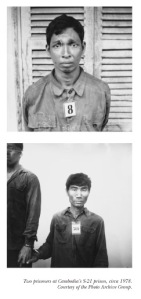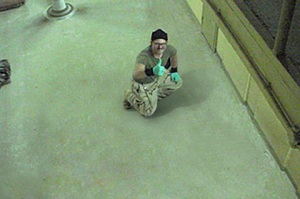The Metropolitan Museum of Art’s current blockbuster, The Pictures Generation 1974-1984 is on the one hand a sprawling historical survey, and yet also a revisionist history. Jerry Saltz describes it as “less a critical survey of a highly influential aesthetic than a feel-good class reunion. Rather than opt for scholarship and tough choices, curator Douglas Eklund cultivated a gang’s-all-here coziness. It’s a huge show, with hundreds of objects, books, posters, films, and videos, and works by 30 artists.”

Philip Smith, All the Answers, 1998
Given the breadth of the show and its apparently inclusive approach, it is particularly surprising that Philip Smith was not included, even though he was one of the five artists that Douglas Crimp selected for the original “Pictures” show at Artists Space in 1977. Crimp’s revised essay, published several years later in October, is arguably responsible for the enduring currency of the “Pictures” moniker, and substitutes Cindy Sherman for Smith. It’s a critical decision that the Met has apparently perpetuated; Eklund has explained to CultureGrrl that “I didn’t respond strongly enough to his work to include it.”
Fair enough.
Remembering that chief photography curator Malcolm Daniel explained the Met curator’s mission as “To collect, preserve, study, exhibit, and stimulate appreciation for and advance knowledge of works of art that collectively represent the broadest spectrum of human achievement at the highest level of quality, all at the service of the public and in accordance with the highest professional standards,” it is clear that Eklund had the license to exclude Smith on the grounds of quality alone.
What disturbs me more is the way that the Met has entirely erased Smith’s inclusion in the original exhibition. At least one wall label for a work by Tory Brauntuch mentions him as one of the four artists in the Artists’ Space exhibition. The didactic material here needs to be qualified.
Reviewing the show, Martha Schwendener perpetuates the error: “The show at Artists Space featured only four artists. Ironically, neither Cindy Sherman nor Richard Prince, who would become figureheads for Pictures art, were included.”
So what happened to fact-checking? The museum gift shop, at the exit to the exhibition, is discretely selling copies of the catalogue for the Artists Space show (only $30). One need only flip to the title page to see that Crimp’s artists numbered five: Troy Brauntuch, Jack Goldstein, Sherrie Levine, Robert Longo, and Philip Smith. CultureGrrl cornered Crimp at the press preview and asked what he thought of the omission:
Q: What do you make of Philip Smith’s absence from the Met’s show?
A: He was not so much of the group, of the social world, of the people who formulated this. He’s gay and this [the Met’s show] is a very straight configuration of artists. I don’t know what’s happened to him, career-wise. It’s a slightly touchy subject: I think Philip is upset, reasonably.
Schwendener rightly points out that the show “was organized by a photography curator intent on showing how the medium was integrated into “mainstream” contemporary art.” Beyond the social circle aspects of the show that Crimp and Saltz emphasize, I wonder if Eklund’s curatorial omission also has to do with the fact that Smith’s work seems to be grounded in drawing.
Whatever Eklund’s his reasons for excluding Smith, the historical record is being distorted. It might not make good copy for wall labels and audio guides, but this decision making process should be more transparent, or at least represented truthfully in the history of Pictures.


 If you read any of the major international art magazines then you have probably realized that earlier this year marked the 100th anniversary of the First Futurist Manifesto. Filippo Tommaso Marinetti’s impassioned rant still holds some water evidently. Thus we get Maurizio Cattelan posed in any number of historically inspired states of buffoonery.
If you read any of the major international art magazines then you have probably realized that earlier this year marked the 100th anniversary of the First Futurist Manifesto. Filippo Tommaso Marinetti’s impassioned rant still holds some water evidently. Thus we get Maurizio Cattelan posed in any number of historically inspired states of buffoonery. Over at Modern Art Notes Tyler Green has an
Over at Modern Art Notes Tyler Green has an 



 In order to give this post some relevance to the art world, I’ll mention that the dominant “rhetorical” flourish in Chelsea right now would have to be a gallows humor.
In order to give this post some relevance to the art world, I’ll mention that the dominant “rhetorical” flourish in Chelsea right now would have to be a gallows humor.

Historical Erasure Follow-Up: Holland Cotter
May 31, 2009In the Saturday NY Times recent Pulitzer Prize winning critic Holland Cotter addresses some of the “history” issues concerning the Met’s Pictures Generation that I brought up in the previous post:
Kudos to Cotter for bringing this to the fore. I assumed that he won the Pulitzer mostly for his feature-style criticism from China leading up to the Olympics, and this article works in the same vein. Cotter discusses two shows that he has already previously reviewed for the Times, and considers the ways in which exhibitions, rather than serving as objective truths, are involved in their own form of historical production and narrativization. In this sense it foregrounds the curatorial responsibility (and imperative) in establishing a context for making meaning.
The article compares the roles of history making in the Pictures Generation and the New Museum’s Younger than Jesus. Interestingly, the web version of the Cotter’s text is illustrated with Elad Lassry’s photographs, whose films I have written about previously. Although Lassry goes unmentioned in Cotter’s article, and his review of YTJ, it is an appropriate editorial decision as Lassry very deliberately engages the forms of production and aesthetic strategies laid out by Pictures artists, making explicit the connection between the two shows. In particular Lassry has a strong connection, even reconsideration, of Jack Goldstein’s motifs, buttressed by the work of Sarah Charlesworth and Dara Birnbaum and David Salle and James Welling. While I am obviously interested in Lassry’s work, I think it fares poorly in YTJ; a lot of this has to do with context and installation: his photographs are small and intensely formal, and in the slapdash cacophony of the third floor, they are almost easy to miss. The side gallery in which they hang is shared with Matt Keegan’s work, presumably because they both engage the Pictures legacy (Keegan with Barbara Kruger explicitly referenced), but it is to the detriment of Lassry’s presentation. Though I won’t go into it here, I had problems with the installation throughout YTJ.
UPDATE: Several weeks before Cotter or I wrote about this, Regina Hackett, also quoting CultureGrrl, posted about Smith’s exclusion. I had also read the AiA interview she cites, and it was influencing my thoughts, but I couldn’t remember the source of the “qualitative exclusion”. To reiterate, it seems like it would have been a minor thing to include Smith in such a sprawling show, and also satisfied historical accuracy.
Tags:Elad Lassry, Holland Cotter, Philip Smith, Pictures Generation, Younger than Jesus
Posted in Media Commentary | 3 Comments »